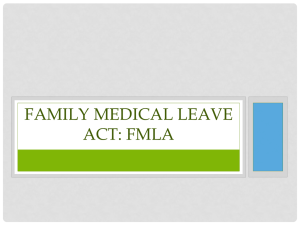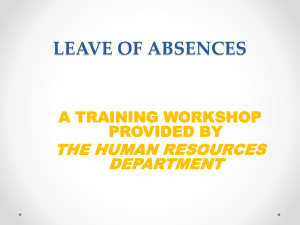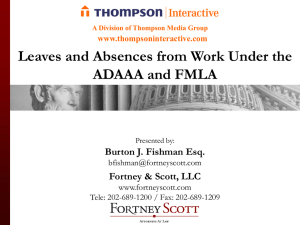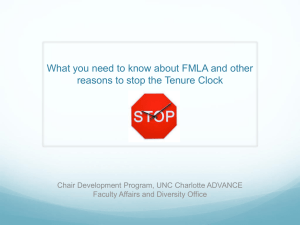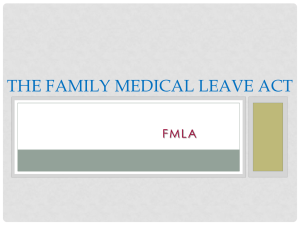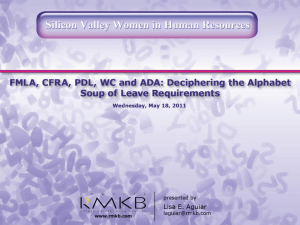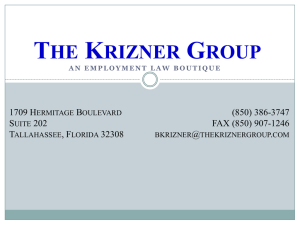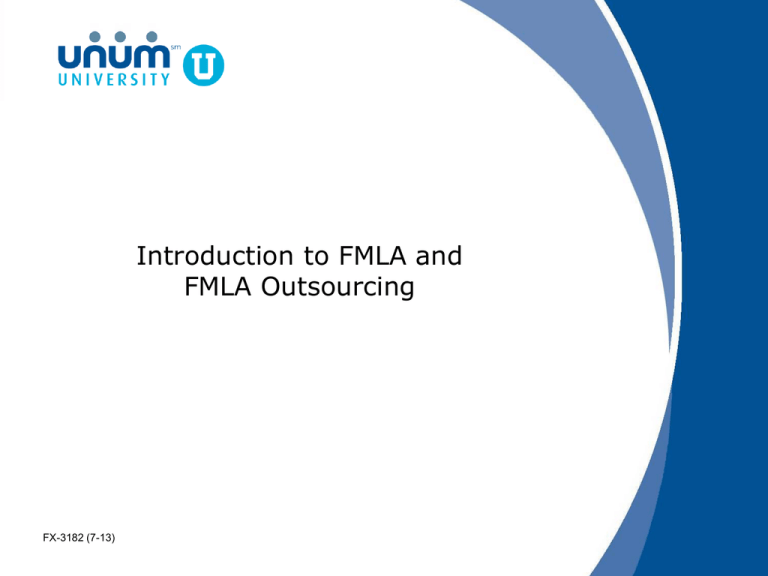
Introduction to FMLA and
FMLA Outsourcing
FX-3182 (7-13)
Presentation Content
• FMLA History
• FMLA 101
• Legal Considerations
• Employer Challenges
• FMLA Administrative Options
• Impact of Lost Time: What are the Costs?
2
FMLA History
FMLA History
FMLA History
• Enactment
The Family Medical Leave Act (“FMLA”) of 1993 was enacted on
February 5, 1993 and became effective on August 5, 1993 for most covered
employers.
• Revisions
New regulations interpreting the FMLA were issued in November
2008 with an effective date of January 16, 2009, these amendments included
active duty and military caregiver leave. Additional revisions issued February
6, 2013 (effective March 8, 2013) implementing National Defense
Authorization Act for Fiscal Year 2010 and the Airline Flight Crew Technical
Corrections Act.
• Accountability
The United States Department of Labor is the
governmental agency responsible for enforcement of the FMLA.
• Coverage
Nearly 60% of employees meet all criteria for coverage and
eligibility under FMLA.1
• Utilization
Based a 2012 survey, 13% of all employees reported taking
leave for a FMLA reason in the past 12 months.2
1, 2 Source: US Dept of Labor Wage and Hour Division, FMLA is Working (2013).
4
FMLA 101
Employer Obligations
An employer must, within predetermined time frames:
Evaluate eligibility for leave
- Hours worked
-
Tenure
- Location
- Employee Status
Calculate entitlement for leave
- How much time available
-
Coordination with state leave laws
Determine qualification of leave
- Meet the definition of a serious health condition or military leave entitlements
-
through review of employee-provided medical certification or information
Meet the definition of non-medical leaves
Applicable state leave laws
Confirm in writing within 5 business days of notice for leave:
- Eligibility
-
Rights and responsibilities
Confirm in writing within 5 business days of receipt of information:
-
Designation of leave
6
Methods for Calculating FMLA Leave
Fixed year Method:
•
Under the fixed 12-Month Period method, an eligible employee (EE) can take
up to 12 weeks leave at any time within the fixed 12-month period selected.
Employer can select one of the following:
– The Calendar year.
– Any other 12-Month period.
Rolling Forward Method:
•
Under the forward method, an EE’s 12-Month period starts on the day the
EE’s first FMLA leave begins and ends 12 months later. The EE can take 12
weeks of FMLA leave during that 12-month period. The EE’s next 12-month
period begins the first time he/she takes FMLA leave after completing the
previous 12-month period.
Rolling Backward Method:
•
Under the backward method, an EE’s 12-month period is measured backward
from the date an EE uses any FMLA leave. Every day an EE takes FMLA leave
(including intermittent leaves) he/she is entitled to any remaining balance of
the 12 weeks of leave that has not been used during the immediately
preceding 12-month period.
Note: Flight crew employees have fixed entitlements of 72 days for ‘regular’ FMLA
and 156 days for military caregiver leave
7
Who is Covered by the FMLA?
Which employers are covered?
•
Private Sector: 50 or more employees for at least 20 weeks in the current or
preceding calendar year.
Which employees can take FMLA leave?
•
•
•
Been employed for at least 12 months (does not need to be consecutive)
– Any week in which employee is maintained on the payroll counts
(including weeks when no work is performed)
Employed at a site with 50 or more employees within a 75 mile radius of
larger site
Has worked at least 1,250 hours during the 12 months prior to the leave
request (consecutive)
– Only actual work time counted
– Leaves of absence, paid or unpaid, including FMLA leave, not counted
– Pursuant to USERRA, employees returning from military service shall be
credited with hours that would have been performed but for the military
service.
What about Temporary employees?
•
Time worked counts toward employee’s hours and tenure requirements
Note: Flight Crew members have different requirements based on airline
industry scheduling equivalents
8
When Can an Employee Take FMLA Leave?
• Birth of a child
• Placement of a child for adoption or foster care
• To care for a spouse, child, or parent with a serious health
condition
• Because of the employee’s own serious health condition
• Because of a Qualifying Exigency
• To care for a family member injured in the line of duty –
Military Caregiver leave
9
Birth of a Child
• Both mothers and fathers are eligible
– But if they work for the same employer, they are only entitled to 12
weeks jointly
• They can split up the leave however they want
• Can overlap
• Each spouse eligible to take his or her own remaining weeks for
other purposes
• Remember, this is a separate kind of leave from leave
related to pregnancy
10
Adoption or Foster Care
• Covers absences required in order for the placement to
occur
–
–
–
–
Attorney meetings
Court appearances
Doctor visits
Going to pick up the child
• Foster care leave only applies to arrangements sanctioned
by state
– Employer has right to request documentation
– Rule applies even if children are relatives of your employees
11
Care for Loved Ones
• Spouse
– Husband or wife as defined by state law.
– Includes common law marriage
• Son or daughter
–
–
–
–
–
Biological child
Adopted or foster child
Stepchild
Legal ward
Any child employee has day-to-day responsibility for (practical or
financial care if the person intends to assume the responsibility of a
parent)
– Under 18, or incapable of caring for herself due to mental or physical
disability at the time FMLA leave is to commence.
• Parent
– Biological or adopted parents
– Does not include in-laws or grandparents, except if that individual acted
as a parent to the employee when he/she was a child
• You can request documentation – but proceed with care!
12
General Categories of Serious Health Conditions
• Inpatient care
• Pregnancy-related conditions
• Continuing Treatment: incapacity and treatment
• Chronic health conditions
• Permanent long term condition
• Treatment to prevent incapacitation or restorative surgery
13
Serious Health Condition: Examples
•
Allergies
•
Asthma
•
Alzheimer’s disease
•
Diabetes
•
Epilepsy
•
Mental illness
•
Restorative/plastic surgery
after an injury
•
Removal of cancerous tumors
•
Stroke
•
Substance abuse
* Remember: applies to employee or loved one
14
Examples of medically-related absences NOT
typically covered by the FMLA
• Routine check-ups
• Minor illnesses, injuries
– Even if there is a doctor’s visit
• Child falls on playground at school, needs stitches
• Employee goes to emergency room with chest pains, turns out to be
gas
• Elective cosmetic treatments not requiring inpatient care
– Lasik eye surgery
– But if inpatient care is required (as part of standard treatment, or due to
complications) it will qualify.
• Absences caused by substance abuse
– But absences caused by treatment for addiction typically will be covered.
15
Military Amendments
•
Active Duty Leave
• Up to 12 weeks of unpaid leave to address a qualifying exigency arising
out of the fact that a spouse, son, daughter, or parent of the employee is
on covered active duty (or has been notified of an impending call or order
to covered active duty) in the Armed Forces.
• Covered active duty includes members of both the regular and reserve
components of the Armed Forces.
• Covered active duty must involve deployment to a foreign country.
• Qualifying Exigency is specifically defined by the regulations.
16
Qualifying Exigency
• To address any issue that arises as a result of short notice
deployment of 7 or less calendar days. (7-day limit on this
leave)
• To attend military events and activities related to the active
duty or call to active duty, includes family support or
assistance programs and informational briefings.
• Child care and school activities
–
–
–
–
To arrange for alternate child care
To provide child care on an urgent immediate need basis
To enroll in or transfer to a new school or daycare
To attend disciplinary meeting with school or daycare (arises out of
active duty or call to active duty).
17
Qualifying Exigency (continued)
• Financial and legal arrangements
– Make or update financial or legal arrangements to address absence.
– To act as covered military member’s representative before an agency
regarding military benefits.
• Counseling
– To attend counseling (other than by healthcare provider) for oneself, the
covered military member or the child, provided need for counseling as a
result of active duty or call to active duty.
•
R&R leave (15-day limit)
– To spend time with covered military member during periods of
deployment
• Post-deployment
– To attend ceremonies, briefings, etc. for a period of 90 days following the
termination of active duty status.
18
Qualifying Exigency (continued)
•
Parental Care
– Must be parent of servicemember who is incapable of self-care
– To arrange for alternate care when the active duty or call to active
duty status necessitates a change in existing arrangements
– To provide care on an urgent immediate need basis when the need
to provide care arises from the active duty or call to active duty
– To admit or transfer to a care facility when admittance or transfer is
necessitated by the active duty or call to active duty
– To attend meetings with staff at a care facility (e.g. hospice or social
service providers) when meetings are necessary due to
circumstances arising out of active duty or call to active duty
•
“Catch-all”
– To address other events provided employer and employee agree it is
a qualifying exigency and agree to timing and duration.
19
Military Caregiver Leave
•
Leave to provide care for covered service member who is employee’s injured spouse,
son, daughter, parent, “next of kin.”
•
Covered servicemember - current member or veteran of either the Armed Forces,
National Guard, or Reserves
– veteran’s discharge or release must be under conditions other than dishonorable
during the 5-year period preceding the start of leave
– October 28, 2009 – March 8, 2013 excluded from 5-year period
•
Not a SHC (serious health condition); a “serious illness or injury” incurred by service
member in the line of duty on active duty, and which may render service member
unfit for duty.
•
Serious injury or illness extended to also mean those that existed before the
beginning of the member’s active duty which were aggravated by service in line of
duty on active duty.
– “In the line of active duty” is defined in military regulations to include any injury
suffered while in the military, even if not caused by the performance of military
duties, i.e. cancer.
– There is an exclusion for injuries caused by the service member’s misconduct.
20
Military Caregiver Leave
• An eligible employee is entitled to 26 work weeks of leave to
care for a covered service member with a serious injury or
illness during a single 12-month rolling forward period,
regardless of the calculation method used by an employer.
– Different (and potentially separate) 12-month period(s)
– The leave entitlement is applied on “per-service member, per-injury
basis” such that eligible employee may be able to take more than one
period of 26 workweeks of leave if leave is to care for different covered
service member or same service member with subsequent injury or
illness; but maximum 26 weeks in each 12 month period.
– Employee entitled to both caregiver leave and regular FMLA (even for
same SHC of covered military member).
– Maximum 26 weeks in each 12-month period for “regular FMLA” and
“military caregiver leave.”
– Employer responsible for designating leave as FMLA qualifying.
21
Types of Leave
• Single Block of Leave:
• Intermittent Leave: Leave taken in separate blocks of time for
a single illness or injury.
– Can be for planned treatments
– Or for conditions which “flare up” unexpectedly and prevent employee from
doing his job (migraines, arthritis, lupus, bad back, etc.)
• Reduced Leave schedule: Leave which results in regular
alteration/reduction of scheduled work hours during the
certified period.
– Employee is entitled to be given a reduced leave schedule if condition
qualifies
• FMLA does not require an employer to allow employees to take
intermittent or reduced schedule leave for bonding; however,
an employer can choose to allow under their leave policies
• An employee cannot be forced to take off more time than he
needs
22
How Do You Deduct Leave for Intermittent or
Reduced Schedule Absences?
• FMLA leave is based on the employee’s normal workweek.
– If employee normally works a 5-day week and takes off one day, the
employer should deduct 1/5 of a week of FMLA leave
– If employee who normally works an 8-hour day is put on a 4-hour per
day reduced leave schedule, he would use ½ week of FMLA leave each
week
• When employee works part time, FMLA deduction is made
on a pro-rata basis by comparing new schedule with old
schedule.
– If employee normally works 30 hours per week, but is put on a 20-hour
per week reduced schedule, he is using 1/3 week of FMLA leave each
week.
23
Intermittent and Reduced Schedule Leave
• Increment of time clarified
– Employer must account for leave using increment no greater
than the shortest period of time that employer uses to account
for other forms of leave
• Increment cannot be greater than 1 hour
• Cannot reduce by more than amount of leave actually taken
• If increments for other forms of leave vary based on time of
day or shift, FMLA increment can vary as long as it remains
consistent with other forms of leave taken at the same time
of the day
– Flight Crew increment no greater than 1 day
24
Tips for Managing Intermittent Leave
• Remember eligibility rule – once employee is deemed
eligible, he remains so for 12 months going forward
– But he still can only take 12 weeks during your chosen 12-month period
• Always require medical certification
– Form should specifically state whether intermittent or reduced leave is
required – send it back if it does not
– Require recertification as allowed by the regulations
• Require foreseeable leave to be scheduled so as to be least
disruptive to your operations
25
Tips for Managing Intermittent Leave
• Consider possibility of temporary transfer to a position
where intermittent absences won’t have such an impact
–
This is only allowed for planned medical treatment
• Carefully track all time
• Be careful about enforcing attendance policies
– Check with Human Resources
26
Legal Considerations
FMLA/Leave Management Services
Scope and complexity of the law
ND
MT
WA
OR
IL
KS
IN
MO
OK
NM
WV VA
NC
TN
AR
MS
TX
NY
AL
GA
MA
RI
CT
PA
OH
KY
CA
AZ
MD
IA
NE
CO
ME
MI
WY
UT
NH
WI
SD
ID
NV
VT
MN
NJ
DE
DC
SC
LA
FL
AK
HI
Key: colored areas indicate states
with additional leave regulations
28
State Leave Laws
• FMLA-like Leave Laws
• Pregnancy disability
• Bonding
• Bone marrow
• Volunteer Fire Fighters (Emergency workers)
• School Activities Leave Laws
• Domestic Violence/Crime Victim Leave Laws
• Kin Care
29
Top 10 Mistakes
1.
Improperly determining
eligibility
6.
Failure to properly
designate FMLA time
2.
“Deeming” employees
FMLA eligible
7.
Inappropriate use of
medical certifications
8.
Failure to request a new
certification and
redetermine eligibility
in a new leave year
Improper use of
recertifications
3.
Failure to provide
required notices
4.
Using a calendar year 12
month period
9.
5.
Failure to calculate leave
entitlement appropriately
10.
Failure to monitor
intermittent leaves closely
30
The risk of Non-compliance
Failing to comply with the law can be costly.
Managers can be held personally responsible for violations.
Companies can be faced with expensive legal fees and settlement fees.
The Case:
In Schultz v. Advocate Health and Hospitals Corp., a long-time employee
alleged his former employer terminated him in retaliation for using FMLA to
care for his two ill parents.
The employee took intermittent leave over several months and during this
period began having problems with his supervisors who established
performance standards he was unable to meet. The problem escalated until
the employee was terminated.
The Result:
A federal jury awarded $11.65 million to the employee. The award consisted
of $10.75 million against the employer and $900,000 individually against the
two supervisors.1
1
Schultz v. Advocate Health and Hospitals Corp., N.,D. Ill., No. 01 CV 702, 10/30/02.
31
The Risk of Non-compliance
Failing to comply with the law can be costly.
Managers can be held personally responsible for violations.
Companies can be faced with expensive legal fees and settlement fees.
The Case:
In Allen v. A.G. Edwards & Sons*, Inc., the Plaintiff, Donald Allen brought suit
against his employer, A.G. Edwards & Sons, Inc. for violations of the ADA and
FMLA as well as State Laws on constructive discharge. In 2001, he was
diagnosed with Bi-Polar disorder and briefly hospitalized. When he returned
to work, the company refused to reinstate him to his old job. A.G. Edwards
had options under FMLA and ADA but was concerned about the Plaintiffs
ability to perform his job. Allen claimed he was demoted to a Financial
Consultant job that required him to report to the former Assistant Branch
Manager and was not reinstated to an equivalent position. The Employer
argued that there was no FMLA violation because they had returned him to a
manager position.
The Result:
The arbitration panel ultimately found for the Plaintiff and found that the
Employer violated the FMLA . Allen was awarded 1.25 million dollars.
*NASD #04-06092, June 26, 2006
32
The Risk of Non-compliance
Failing to comply with the law can be costly.
Managers can be held personally responsible for violations.
Companies can be faced with expensive legal fees and settlement fees.
The Case:
Lubke v. Arlington*. The Plaintiff, Kim Lubke sued the City of Arlington,
alleging he was discharged in violation of FMLA as a result of missing work to
care for his ill wife. Lubke was scheduled to work from December 31, 1999
through January 1, 2000. On December 30, 1999, Lubke telephoned a call
box and left a message stating that he would not be working during the Y2K
weekend because he needed to stay home with a sick wife. Lubke was
terminated for dereliction of duty, unauthorized absence and insubordination.
At trial, the employer asserted that Lubke’s leave was not protected by the
FMLA because he failed to provide timely and adequate medical certification
required supporting his claim leave.
The Result:
The jury rejected the employers claim and found that the employer had
violated the FMLA and awarded Plaintiff over 1 million dollars in damage. On
appeal, the Fifth Circuit affirmed the jury verdict.
*2006 WL1793268, June 30, 2006
US Court of Appeal, Fifth Circuit
33
The Risk of Non-compliance
Failing to comply with the law can be costly.
Managers can be held personally responsible for violations.
Companies can be faced with expensive legal fees and settlement fees.
The Case: Lore v. Chase Manhattan Mortgage Corp*. The Plaintiff, Nicholas
Lore, requested leave to address several health issues. He was told an
additional manager would be hired to assist with his responsibilities and
enable him to take leave. When the additional manager was not hired, Lore
inquired of his manager again requesting leave. Less than one month later,
Lore was terminated. Lore sued Chase Manhattan for failing to grant him, an
eligible employee, leave under the FMLA. In addition, Lore argued Chase
Manhattan unlawfully retaliated against him for his attempts to exercise his
rights under the FMLA.
The Result: A jury found for the employee and awarded him $2,227,241.
With liquidated damages equal to the amount of the verdict and prejudgment
interest added in, the recovery equaled between $6.2 and $7.6 million.
*2008 Lore v. Chase Manhattan Mortgage Co., 2008 WL 2404425 (N.D. Ga., 2008)
34
The Risk of Non-compliance
Failing to comply with the law can be costly.
Managers can be held personally responsible for violations.
Companies can be faced with expensive legal fees and settlement fees.
The Case: Dotson v. Pfizer*. The Plaintiff, Dotson was seeking to adopt a
child from Russia and took intermittent time off to attend to the adoption,
taking two trips to Russia. The employee kept his employer informed and
spoke to his HR Dept. After returning from Russia with the child, the
employee was terminated based on an alleged violation of company policy.
Dotson sued for FMLA retaliation. The employer argued that the employee
was not entitled to FMLA protection because he failed to indicate that he
needed FMLA leave. The court rejected this argument, noting that an
employee does not have to expressly state that he needs FMLA or use any
magic words to trigger the employer's obligation.
The Result: A jury found for the employee and awarded him more than $1
million plus prejudgment interest. The employer appealed but the court
affirmed the decision in the employee’s favor. The court also held that the
lower court erred when it failed to award the employee prejudgment interest,
making the judgment even larger than that awarded by the jury.
*2009 Dotson v. Pfizer, No. 07-1920 (4th Cir. March 4, 2009)
35
What Can You Do About Abuse of FMLA?
• Strictly follow certification requirements
• Don’t be afraid to seek clarification or ask for second or
third opinions, particularly when dealing with employees
with a history of attendance problems
• Be consistent – don’t selectively enforce
• Put everything in writing, it gives employees less “wiggle
room”
• Stay in touch with absent employees – there is no
prohibition against contacting them, asking about their
status
• Keep your eyes and ears open – if circumstances have
changed, request recertification
– But your documentation must be solid
36
Employer Challenges
Key FMLA Findings From Employers
The most frequently cited HR organizational challenges with FMLA*:
Source: DMEC/Spring Consulting, 2012 Employer Leave Management Survey (2013).
38
The Challenges Facing Employers
• Leave policies must comply with both federal and state leave laws
• Each leave request must be individually evaluated for eligibility and
qualifying conditions
• Documentation must be collected, verified, recorded and filed for every
leave request
• Managers may be found to be individually liable. Employers are
subject to fines and/or other penalties if there is a violation of the FMLA
• Intermittent leaves are difficult to track
• It is difficult to coordinate STD & FMLA when they are outsourced
separately
• Retention and termination of employees
• Productivity and employee morale
• Indirect costs of covering absences (overtime, temporary workers, outside
contractors)
39
FMLA Administrative Options
FMLA Administrative Options
• In-source-Decentralized model
• In-source-Centralized model
• Outsource-TPA
• Outsource-Carrier/TPA
• Outsource-Carrier with dedicated capabilities
41
Lost Time Costs
The Costs of In-house Administration
•
Productivity
– Employee leaves disrupt work routines and cause confusion and distraction
among remaining staff
– Leaves can require replacement workers and/or overtime wages
– Managers must consider any impact of FMLA absence separately from other
performance issues, complicating the entire management process
• Legal/Compliance
– State leave laws are numerous and change often. Employers and their legal
counsel must constantly survey court rulings and changes in the laws to remain
up-to-date.
– Failing to comply with the law can be costly and managers can be held personally
responsible for violations
– Litigation costs are roughly $100K to $200K per claim not including settlement
costs.1
• Tracking & Administration
– About half of employers report that the cost of complying with FMLA has increased over the
years. Less than 1% said the cost decreased.2
– Other tracking and administration costs include maintenance of records, storage
and supplies in conjunction with the administration of other benefits such as STD
and workers compensation.
1
2
Based on Unum internal experience, 2007.
ABT Associates for U.S. Dept of Labor, Family and Medical Leave in 2012: Technical Report (2013).
43
FMLA Administrative Options
In-Source versus Out-Sourcing-Factors to consider:
• Employer Size
• Demographics
• Industry
• Location and number of operational sites
• Absence Management Philosophy
• Company Culture
• Current Capabilities
44
Outsourcing Evaluation - Look for Robust
Leave Management Services Capabilities
• Whether managing in-house or with a Carrier/ TPA, look for
these capabilities:
–
–
–
–
–
–
–
–
–
–
Single integrated solution, one vendor administering STD and FMLA
Single point of intake (STD/FMLA)
Web based reporting that allows drill down into data
Real time updates to changes in state leave laws or federal
In-house legal and technical expertise, includes newsletter to employer
Proven scale with large customer base and covered lives, strong customer
persistency
Superior customer satisfaction survey results
Administration for all separate state leave laws
Look for case studies showing enhanced productivity though reduction of lost
time
Indemnification
45
The Case for Integration
Because of the significant overlap that exists between short term disability and FMLA
leaves, managing these leaves separately can cause additional costs and result in
employees absent from work longer than entitled.
46
Clients benefit from our Centers of Excellence
Employer
or Employee
Toll-free call
Absence Management
Specialist
•
Intake new
leave/Claim and
inform employee
•
Set expectations
and next steps
•
Record intermittent
hours
•
Answer questions
related to leave and
disability claim
STD Specialist
► Quarterback of the overall
process
► Determine eligibility
► Assess medical expertise for
disabling condition
► Evaluate functional capacity
► Complete job analysis
► Calculate benefits
► Support return-to-work
efforts
► Support integration with
health programs
Absence Management Team
Absence
Management
Specialist
Knowledgeable about
customer’s unique needs
FMLA
Specialist
Clinical Resources
Legal Counsel
STD
Specialist
Clinical Resources
Vocational Resources
FMLA Specialist
► For disability claims, follows STD decision
► State and Federal leave eligibility and designation
► Coordination between Federal, State and Corporate
policies
► Family leave, bonding
► Intermittent management
47
Lost Time Costs
The Total Financial Impact of Employee Absences Survey Highlights October 2008
Mercer Guy Carpenter, Oliver Wyman
48
Lost Time Costs
The Total Financial Impact of Employee Absences Survey Highlights October 2008
Mercer Guy Carpenter, Oliver Wyman
49
The Big Picture!
The Total Financial Impact of
Employee Absences Survey
Highlights October 2008
Mercer Guy Carpenter, Oliver
Wyman
50
Case Study-Intermittent Leave Management*
Company-Outdoor Clothing and Gear Retailer
•
# US Employees
4,500 year round
11,500 at peak (December)
•
Products & Services – Retail Sales
Offering clothing and outdoor gear for customers to enjoy the outdoors.
Contact Centers provide world class legendary service to customers
•
4 year round centers & 1 seasonal center in Northern New England
•
Handle inbound order & customer service calls 24 hrs/day, 7 days/week 365 days a year
•
Daily Call Volume: 35,250 calls off peak; 133,500 calls during peak
•
Call Center Operations are supported by centralized planning functions
(Finance, Systems/Technology, Quality, Training, Workforce Planning)
*This case study is true, although the employer name and other identifying characteristics have been removed or changed to
preserve confidentiality.
51
Case Study-Intermittent Leave Management
1,170 call center staff year round increasing to over 4,340
employees at Peak
•
•
Annual Turnover: 7-8%
Short term disability Absence in ‘05 – 2,850 days (est.
equivalent of 11 FTE’s)
•
Workers’ Compensation Lost Time in ‘05 – 53 days
•
Intermittent FMLA Absence:
Year prior to outsourcing:
Equivalent of 1,100 days or est. 92 days/month
First 5 months after outsourcing:
Reduced to the equivalent of 187.5 days or est. 38 days/month
58.7% reduction in lost time
52
Questions
53
Introduction to FMLA and
FMLA Outsourcing
Unum
1 Fountain Square
Chattanooga, TN 37402
unum.com
© 2013 Unum Group. All rights reserved. Unum is a registered trademark and marketing brand of Unum Group and
its insuring subsidiaries.
Insurance products underwritten and services offered by the subsidiaries of Unum Group. For broker and employer
information.
FX-3182 (7-13)
54

